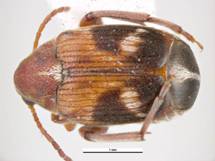
| Home |
| SUGARCANE |
PRIMARY STORAGE PEST |
INTERNAL FEEDERS |
| 1. Rice weevil |
| 2. Lesser grain borer |
| 3. Angoumois grain moth |
| 4. Pulse beetle |
| 5. Cigarette beetle |
| 6. Drug store beetle |
| 7. Tamarind Beetle |
| 8. Sweet Potato weevil |
| 9. Potato tuber moth |
| 10. Arecanut beetle |
EXTERNAL FEEDERS |
| 11. Red flour beetle |
| 12. Indian meal moth |
| 13. Fig moth or almond moth |
| 14. Rice moth |
| 15. Khapra beetle |
SECONDARY STORAGE PEST |
| 16. Saw toothed grain beetle |
| 17. Long headed flour beetle |
| 18. Flat grain beetle |
| 19. Grain lice |
| 20. Grain mite |
| Questions |
| Download Notes |
STORED GRAIN :: PRIMARY STORAGE PEST :: INTERNAL FEEDERS :: PULSE BEETLE
4. Pulse beetle: Callosobruchus maculatus (chinensis) (Bruchidae: Coleoptera)
Distribution and status
USA, Mauritius, Formosa, Africa, China, the Philippines, Japan, Indonesia, Sri Lanka, Myanmar and India.
Host range : Gram, mung (Phaseolus aureus), moth (Phaseolus aconitifolius), peas, cow peas, lentil and arhar (Cajanus cajan), cotton seed, sorghum and maize.
Bionomics : Larva is whitish with a light-brown head. The mature larva is 6-7 mm long. The adult beetle measuring 3-4 mm in length, is oval, chocolate or reddish brown and has long serrated antennae, truncate elytra, not covering the pygidium.
 |
 |
The pest breeds actively from March to the end of November. It hibernates in winter in the larval stage. A single female lays small, oval, scale like 34-113 eggs at the rate of 1-37 per day. Egg period is 6 -16 days, larval period 10 -38 days. The hibernating larvae take 117-168 days to complete their development. The pupal stage lasts 4-28 days. The adult escapes by cutting a circular hole in the seed coat and such grains can be spotted easily. The average life-span of an adult is 5-20 days. The insect passes through 7-8 overlapping generations in a year.
Damage symptoms:
 |
The adult and grub feed on the grain by making a small hole. Infested stored seed can be recognized by the white eggs on the seed surface and the round exit holes with the 'flap' of seed coat. Kabuli types are particularly susceptible.